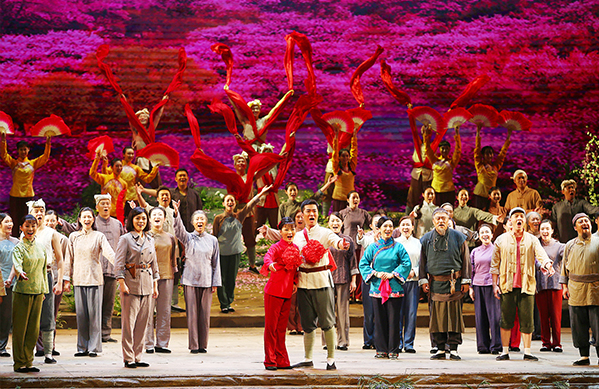Rural literature on social change expected in new era

A performance of the folk opera “Marriage of Xiao Erhei,” adapted from Zhao Shuli’s novel of the same name, at the Beijing Poly Theatre Photo: CFP
Literature on farmers and rural life have never been absent from the “one-century” development of Chinese new literature [Chinese vernacular literature developed after the May Fourth Movement in 1919].
Concerns over the old society
At least three major themes persist within Lu Xun’s [a leading figure of modern Chinese literature; 1881–1936] novels. The first is his contemplation of farmers’ issues. Lu’s works such as “Hometown,” “Medicine,” and “The True Story of Ah Q,” present a world where people like Runtu [a character in “Hometown,” inspired by Lu’s childhood friend, a farmer’s son] and Ah Q [a fictional character famous for his self-deception even when faced with extreme defeat or humiliation], who are the main characters in these stories, suffer sever impoverishment of both their inner lives and material lives. Images of these figures not only represent the old rural life in eastern Zhejiang Province [where Lu’s hometown is located, also his place of inspiration], but have also become the standard representation of Chinese farmers at that time.
The second theme is the dilemma of intellectuals. Lu’s stories like “A Madman’s Diary” and “Kong Yiji” depict how literati and intellectuals in the old society suffered, struggled, and attempted to find a way out of their ideological crises. From the Madman and Kong Yiji’s sorrow of being disillusioned by reality, readers can feel the great difficulty of reshaping one’s inner world while transitioning between old and new society.
The third theme is Lu’s concerns about the well-being of women. Works including “The New Year’s Sacrifice” and “Regret for the Past” reveal the hardship of Hsiang Lin’s wife [a widow in “The New Year’s Sacrifice,” exposed to a sad life that eventually forces her to the external scopes of societal moral standards] and other women in self-identification and self-realization in the old society. Whether born in the countryside or the city, illiterate or educated, cowardly or daring, these women finally converged on the same fate in a cultural context dominated by patriarchy. These three themes symbolize the beginning of Chinese new literature on farmers in a modern sense. The issues of farmers, intellectuals, and women were principle among the realities faced by Chinese people at the time of social transformation. Lu Xun’s works pay particular attention to the lives of Chinese farmers, revealing the writer’s contemplation of this matter in his time.
After Lu Xun, the writer who demonstrated the deepest understanding of peasants was Zhao Shuli (1906–1970). Although some characters in Zhao’s works share the fates of Runtu, Ah Q, and Hsiang Lin’s wife, more “new persons” such as Xiao Erhei and Xiao Qin [a young couple in a small village who fight against their parents’ will to pursue true love, derived from Zhao’s novel, Marriage of Xiao Erhei] emerge. From the character of Xiao Erhei, readers can experience realistic depictions of farmers who have already begun to “stand up” in that era. Indeed, Zhao is “the first writer in the history of Chinese literature to write about the life of farmers in the language and thoughts of farmers,” for the reason that “he is among the people rather than standing by.”
Literature expected in the new era
The Ordinary World was also inspired by a changing China. Its author, Lu Yao (1949–1992), wrote about how Chinese farmers “grew rich” during the period of great transformation. Though the novel only captures a period of ten years between the 1970s and 1980s, its in-depth observation of the growth of urban and rural people during reform and opening up has become a monument of literature in the new era.
Chinese literature on the countryside has been considered among the most accomplished in academia. The roots of such masterpieces stem from writers’ active response to the changing world at the major turning points in history. Around the period of “The Great Revolution” [between 1924 and 1927, a vigorous anti-imperialist, anti-feudal-warlords revolutionary movement swept across China], Chinese farmers had not yet “stood up.” Lu Xun’s “Hometown” and “The True Story of Ah Q” authentically illustrate their true circumstances. During the New Democratic Revolution period [beginning in 1919 with the May Fourth Movement, which enabled Marxism-Leninism to further spread and prepared the ideology for the founding of the Communist Party of China; the founding of the People’s Republic of China in 1949 represents the success in the New Democratic Revolution], examples of farmers who “stood up” can be found in literary works such as Marriage of Xiao Erhei. Lu Yao’s Ordinary World captured the early time of reform and opening up, during which Chinese farmers gradually “grew rich.” Does it therefore follow that the mission of Chinese literature in the new era should be to depict farmers “becoming strong”? My answer is yes.
With the progress of modernization and urbanization, and the growing proportion of urban literature and urban-born writers, rural farmers are being marginalized in the history of literature. How should literature respond to this trend? Writers’ attitudes determine what the literature of the time should look like. Therefore, in the face of great achievements such as poverty alleviation, building a moderately prosperous society in all respects, and rural revitalization, we should seek to create new-era versions of History of Entrepreneurship [a novel by Liu Qing (1916–1978), which records the great changes of rural China after the PRC foundation] and Great Changes in a Mountain Village [a novel by Zhou Libo (1908–1979)].
He Xiangyang is a research fellow and director of the Creation and Research Department of the Chinese Writers’ Association.
Edited by REN GUANHONG
